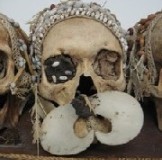 In 1957 the first contact was made along the Casuary Coast by a medical patrol. The hundred kilometre coast and the stroke of land situated inland from the coast were in those days regarded as one of the wildest areas of Papua New Guinea.
In 1957 the first contact was made along the Casuary Coast by a medical patrol. The hundred kilometre coast and the stroke of land situated inland from the coast were in those days regarded as one of the wildest areas of Papua New Guinea.
Doctor Willem Visser, was one of the members of the expedition into this area. An expedition which was certainly not without danger.
“ With this sort of work one never knows, whether or not arrows will fly, or if sago is going to be offered as a sign of friendship when a population of head hunters and men eaters first come into contact with white men in their enormous ship”
In a personal account that he wrote at the time, he stated that “you always need to be on your guard” . The information in this article comes from this personal account by Doctor Willem Visser.
Content
1. A country in the making
2. Head hunting and ritual killing
3. The feared head hunters of Atsj
4. Arival in Atsj
5. James Cook and his contact with native savages
6. Peace Celebrations in Atsj
7. Foiled murder attempt
8. Links
9. Sources
1. A country in the making
“Usually one imagines New Guinea as a barbaric and primitive country, where headhunting savages living in the jungle eating one another. One also imagines that a government official venturing into this jungle to make contact with
wild savages (comparable to some tale on playing cowboys and Indians in the wild west). This is not exactly the correct representation of what happens. New Guinea is in the throws of becoming a modern and more regulated country. It is a 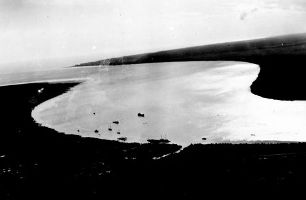 developing country in which nature taxes the endurance of the government officials. In large parts of the country, the native Papuan population is taking part in this development process and the mantri ( Papuans trained by the Dutch) are involved in various service sectors to serve among their own people. In some areas insight into political issues is also developing, but other areas are still ‘blank spots’ on the map. In these area the Papuan is still a traditional savage, a cannibal who headhunts and lives in constant fear. Fear of their own kind and fear of evil spirits. An individual cannot be sure of his life from one moment to the next and there are all sorts of primitive rituals to ward off the unknown.”
developing country in which nature taxes the endurance of the government officials. In large parts of the country, the native Papuan population is taking part in this development process and the mantri ( Papuans trained by the Dutch) are involved in various service sectors to serve among their own people. In some areas insight into political issues is also developing, but other areas are still ‘blank spots’ on the map. In these area the Papuan is still a traditional savage, a cannibal who headhunts and lives in constant fear. Fear of their own kind and fear of evil spirits. An individual cannot be sure of his life from one moment to the next and there are all sorts of primitive rituals to ward off the unknown.”
2. Head hunting and ritual killing
“A head-hunting trip is usually a cowardly attack. The enemy village is surrounded at night. All possible escape routes are cut off, and around sunrise it is time to attack. Bamboo trumpets wake the victims who are initially paralysed with fear and who then take off in an attempt to find shelter. But mostly they end up running straight into the head hunters’ lair. Especially the women and children are easy victims. The captives are killed off brutally. And then the ritual slaughter commences. The muscles and tendons of the neck are cut through with a bamboo knife. The spine is rotated and crunched. The torso is cut open on each side. After 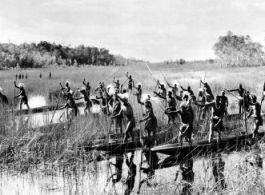 removing the intestines, the arms and legs are severed and loaded onto the prauwen (canoes). The women await in the village. From afar, they can ascertain that the trip has been a success. The meat is roasted and eaten. A hole is made in the skull with a special chisel and both the brains and the jaws are removed. The tongue is also roasted and eaten. There is drumming and dancing, the party continues until sunrise. The monotonous singing can be heard far and wide. Nightfall in the jungle closes in on the dancing barbarians. The song of chirping crickets reaches a crescendo and merges with the drone of male voices: A primeval melody from the Stone Age”.
removing the intestines, the arms and legs are severed and loaded onto the prauwen (canoes). The women await in the village. From afar, they can ascertain that the trip has been a success. The meat is roasted and eaten. A hole is made in the skull with a special chisel and both the brains and the jaws are removed. The tongue is also roasted and eaten. There is drumming and dancing, the party continues until sunrise. The monotonous singing can be heard far and wide. Nightfall in the jungle closes in on the dancing barbarians. The song of chirping crickets reaches a crescendo and merges with the drone of male voices: A primeval melody from the Stone Age”.
3. The feared head hunters of Atsj
In the 1950’s, there was a blank spot on the map of South New Guinea. This was the Cassowary Coast. The following is an account of the first successful attempts to make contact with the tribes of this particular region. The government had the intent to administer the region in some form or other and was sorting out a strategy to do so. It was decided that the first attempt at contact was to be made by a 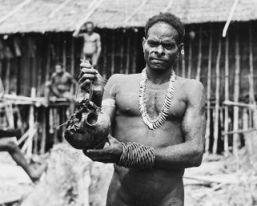 medical patrol team (Doctor Visser being one of them).
medical patrol team (Doctor Visser being one of them).
“Via the Mariannestraat (name of channel), we will first go to Kepi, the main centre of the Mappi area, once inhabited by a wild and war-like tribe. It is thanks to Father Verscheuren and Father Meuwese that peace was brought to this region allowing for change and development. At Kepi we are reasonably close to the Casuary Coast, that is to say as the crow flies, but over land this journey is long and arduous. Using Father Meuwese’s advice, we decide to sail down the Wildeman River and then on to the Eilanden River in order to get to Atsj, an Asmat kampong (native village) not far from Agats, the newly created administrative. Atsj is a big kampong. More than a thousand people live here and they are feared far and wide for their head hunting raids. Women and children are murdered along with the men. In fact, they are the preferred victims as they hardly ever defend themselves “
4. Arrival at Atsj
“Atsj borders on the Casuary Coast area. Father Van Kessel has been posted here and the inhabitants are starting to get used to contact with Europeans. They are happy and excited about our arrival. After all, the arrival of a large boat usually means more tobacco, maybe even a new knife or two.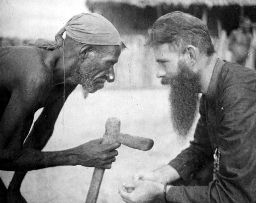 Even though a missionary is living in this kampong, it does not mean that they(the Papuans) have changed their way of life. Less than a year ago, dozens of prauwen (canoes) filled with painted warriors went up the Eilanden River on a head hunting raid to a neighbouring village upstream. More than a hundred heads were brought back and human flesh was consumed for days on end.
Even though a missionary is living in this kampong, it does not mean that they(the Papuans) have changed their way of life. Less than a year ago, dozens of prauwen (canoes) filled with painted warriors went up the Eilanden River on a head hunting raid to a neighbouring village upstream. More than a hundred heads were brought back and human flesh was consumed for days on end.
Atsj has been built on the right hand side of the river. Hundreds of Papuan huts are lined up along the waterfront. The soil is boggy and soft. The walls of the houses are made from gaba-gaba, the nerve of Sago Palm and the roofs consist of layers of palm leaves or atap. All the houses are on stilts. Most of the houses along the Casuary Coast have an exit in the roof because they are built by a people who need to consider the raiding parties out on the kill. Via this exit, it is possible to escape into the forest. In the event of a massive raid, not many people escape because they are totally surrounded and the enemy is waiting for them in the forest.”
5. James Cook and his contact with native savages
“We are exploring the upper Fajit River. Bettekam, the chief of Basiem, the most powerful kampong along the Fajit River, accompanies us. A few months ago before our visit, he had his first encounter with Europeans and this pleased him. We all feel the tension generated by entering unknown territory. No European has ever  come this far. Sometimes we meet with bows and arrows, but it never leads to a real conflict. We proceed and make our way to the mouth of the Cook River. James Cook landed here in 1770 and lost more than ten of his men during a picnic along the beach around here. His party was attacked by native savages carrying barbed spears and bamboo tubes from which lime was thrown. The next contact with these fierce inhabitants was made by Father Verscheuren and Father Muewese in 1948. These missionaries also came across the wild natives. They were confronted by the aggressive attitude of these people and had to retreat the upper reaches of the Cook River, where the population had a more peaceful attitude. This population celebrated the return of the two missionaries because it was rare for anybody to come back unscathed from a trip to the mouth of the Cook River.”
come this far. Sometimes we meet with bows and arrows, but it never leads to a real conflict. We proceed and make our way to the mouth of the Cook River. James Cook landed here in 1770 and lost more than ten of his men during a picnic along the beach around here. His party was attacked by native savages carrying barbed spears and bamboo tubes from which lime was thrown. The next contact with these fierce inhabitants was made by Father Verscheuren and Father Muewese in 1948. These missionaries also came across the wild natives. They were confronted by the aggressive attitude of these people and had to retreat the upper reaches of the Cook River, where the population had a more peaceful attitude. This population celebrated the return of the two missionaries because it was rare for anybody to come back unscathed from a trip to the mouth of the Cook River.”
6. Peace Celebration at Atsj
“Bettekam is not at all happy with the Aorket tribe at Cook Bay. He advises against visiting these people, probably the descendents of the group that attacked Cook. He tells us that the Aroket tribe had held a head hunting raid on Basiem a few months earlier. Naturally, Basiem retaliated and collected a few heads themselves. Bettekam reckons he’ll be better off staying on board and that it will not be safe for him to land. After sailing up the river for a few hours, the kampong comes into view and we notice an excited throng of people on the beach. Before long, a number of prauwen leave the shore; not long after even more prauwen are pushed off into the 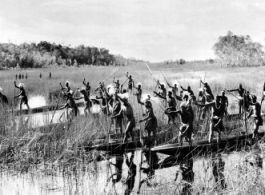 sea and a few minutes later we are surrounded by a large number of canoes hollowed out of trees. Men screaming with excitement bombard us with ethnographic treasures: beautiful drums, shields, spears, stone axes and more are on offer. Suddenly, we see a man holding one of our machetes, another one has managed to get hold of an axe and then we realise that this is in fact an exchange of goods. Obviously, they have heard of our arrival and our riches from neighbouring villages. Bettekam, who was lying low, is impressed by their fearless behaviour. He comes out of hiding and is instantly recognised. An animated conversation develops and Bettekam announces that he is going to spend the night at the kampong. There is going to be a party to celebrate the peace. And sure enough, we hear the beating of the drums late into the night, but we’d decided we would rather stay on board. However, we have to say that we are quite impressed by our ability to pacify the natives.”
sea and a few minutes later we are surrounded by a large number of canoes hollowed out of trees. Men screaming with excitement bombard us with ethnographic treasures: beautiful drums, shields, spears, stone axes and more are on offer. Suddenly, we see a man holding one of our machetes, another one has managed to get hold of an axe and then we realise that this is in fact an exchange of goods. Obviously, they have heard of our arrival and our riches from neighbouring villages. Bettekam, who was lying low, is impressed by their fearless behaviour. He comes out of hiding and is instantly recognised. An animated conversation develops and Bettekam announces that he is going to spend the night at the kampong. There is going to be a party to celebrate the peace. And sure enough, we hear the beating of the drums late into the night, but we’d decided we would rather stay on board. However, we have to say that we are quite impressed by our ability to pacify the natives.”
7. Foiled murder attempt
“About five the next morning we are woken up by Bettekam who is soaking wet . ‘Yes Tuan’, he says, ‘ I decided to go for a swim’. Absolutely confounded, we ask Bettekam what happened, upon which he relates the following. When he landed last night, he was warmly welcomed. But as the evening progressed, he realised that these people were not as friendly as they first made out. The men started bragging about their feats of war, the women were egging them along. And Bettekam clicked: This was the preparation for another head hunting raid and he was in mortal danger. He could not reach the boat. They would murder him without 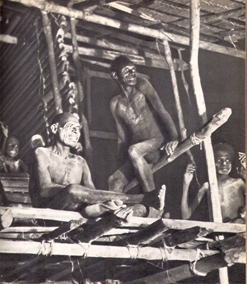 us noticing a thing. He was offered an empty hut to sleep in but he stayed by the fire. He was not going to sleep because anything could happen that night. He was scared stiff. While he was staring into the fire, he heard something rustling behind him. He turned around like lightning and saw three people standing by his hut. Two men had their bow and arrow at the ready. The third was holding a carving knife. They had been expecting to murder Bettekam while asleep but he was not asleep. This gave them a fright. The man with the knife took off and the other two followed suit. The rest of the night, Bettekam stayed by the fire and kept an eye on the doorway. At dusk he took his chances, ran to the sea and swam out to the boat. He was in quite a state, when he told us this story. We were surprised and upset that all this was happening under our very noses. That day and the following one there was not a trace to be found of the people of Aorket.
us noticing a thing. He was offered an empty hut to sleep in but he stayed by the fire. He was not going to sleep because anything could happen that night. He was scared stiff. While he was staring into the fire, he heard something rustling behind him. He turned around like lightning and saw three people standing by his hut. Two men had their bow and arrow at the ready. The third was holding a carving knife. They had been expecting to murder Bettekam while asleep but he was not asleep. This gave them a fright. The man with the knife took off and the other two followed suit. The rest of the night, Bettekam stayed by the fire and kept an eye on the doorway. At dusk he took his chances, ran to the sea and swam out to the boat. He was in quite a state, when he told us this story. We were surprised and upset that all this was happening under our very noses. That day and the following one there was not a trace to be found of the people of Aorket.
We do now rather doubt our attempts at pacifying the tribes.”
8. Links
Refer to:
- Eye witness accounts of head hunting raid
- Film about the Casuary Coast by Jean Pierre Dutilleux
9. Sources
- W.M Visser, Travelling through New Guinea in the fifties (personal diary)